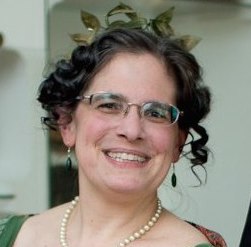- Era: 1830s England
This new and fashionable dance, which it appears is of Russian origin, was first introduced into this country at His Majesty’s ball, St. James Palace, on the 11th June, 1829, when the Princess Esterhazy, the Earl of Clanwilliam, the Duke of Devonshire, and some of the foreign ministers exerted themselves in teachings its novel movements to the company, and was danced alternately with Quadrilles and Waltzing during the whole of the evening.
— J.S. Pollock, Companion to La Terpsichore Moderne (2nd ed), London, c1830
In an earlier post, I described the basic galop of the mid- to late 19th century as a series of slides and “chasing” steps with half-turns interspersed, commonly found in the pattern of four-slide galops, performed as follows:
2b Slide-close-slide-close-slide-close-slide (half-turn) (count: 1 & 2 & 3 & turn)
2b Slide-close-slide-close-slide-close-slide (half-turn) (count: 1 & 2 & 3 & turn)
All slides are performed along the line of dance. The default turning direction is clockwise, though counter-clockwise turns are also possible. The first set are performed with the first foot (gentleman’s left, lady’s right) with the second foot then closing behind in order to again slide with the first foot. The second series is then performed by sliding with the second foot and closing with the first. The galop sequences may also be extended to four bars per set, i.e. “eight-slide” galops.
This description is consistent with most galop sources from the mid-century onward. But oddly enough, that’s not how it’s described in the source from which the quotation above was drawn.
The gallopades Pollock describes are a mix of galop movements and choreographed figures done in a line or circle of couples rather than simply a series of galops around the room; I described one in detail in an earlier post. For the galop sequences, Pollock specifies a “peculiar step and movement” without actually explaining them. But most interestingly, he does not describe the standard pattern of making half-turns after every two or four bars given later in the century. The hold given to start the galop is the familiar one:
…the gent. passes his right arm round the waist of the lady, and with his left hand takes hold of the lady’s right, the lady’s left hand resting on the gent’s. right shoulder — the whole of the couples being thus placed, the ladies are on the outside of the circle.
But at the end of four bars (an eight-slide galop: 1 & 2 & 3 & 4 & 5 & 6 & 7 & 8), rather than making a half-turn:
…the lady crosses to the left of the gent. resting her right hand on the gent’s. left shoulder and holding hands in front as before, which brings the ladies to the inside of the circle.
There are never full turns made in this version of the galop; the lady simply crosses back and forth in front of the gentleman every four bars, moving from a regular ballroom hold to a reverse one. Choreographies given later are specific about this:
…the lady crossing to the other side of the gent. at the end of every four bars.
…the lady crossing to the left of the gent. at the end of the first four bars…the lady crossing back again…
To accomplish the cross, the gentleman should guide the lady firmly around him on the final counts 7&8 (slide-close-slide), making his own steps very short to allow her to move in front of and across his path. Reverse to guide her back to the other side.
While Pollock describes this as the common pattern for the galop sequences within the choreographed gallopades he gives, it also makes an interesting variation for those reenacting later eras of dance who don’t mind being a bit old-fashioned in their style.


Leave a Reply